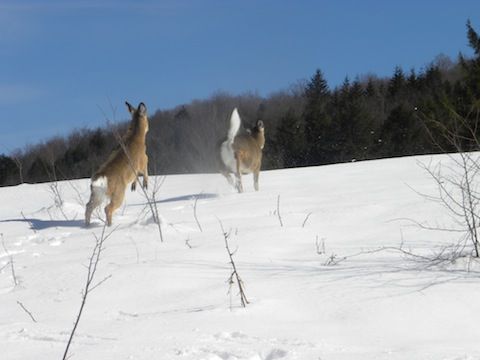
For those that hunt the great white-tailed deer of North America or that are involved in managing for any number of the popular game species, food plots are well known. According to Wikipedia, “a food plot is a planted area set aside to act as a food source for wildlife. The term was coined by the U.S. hunting and outdoor industries. Food plots generally consist of but are not limited to legumes (clovers, alfalfa, beans, etc.) or forage grasses.”
Food plots can be a great way to increase both the nutritional density of vegetation on a small acreage of land, while enhancing wildlife diversity and abundance. For this reason, managers of deer, grouse, quail, bear, turkey, and others continue to implement food plots.
However, food plots can be very expensive and/or time consuming. Many individuals simply do not have the tools to administer one. On flatter terrain, some may get away with using smaller equipment to put in a food plot with an ATV. However, in our stony country, a tractor will probably be required. Also, a tiller, rake, spreader and other large implements will be necessary as well. In addition, food plots must be maintained annually with more tractor work, herbicides (which are not cheap), and time. Again, there is no doubt that food plots help sustain wildlife populations, but can our wallets sustain them?
So, what are some other options forest landowners have at their disposal? The answer may lie in what the land already has to offer – forests. In comparison, forest food plots require far fewer expensive tools and less yearly maintenance to boot; just a chainsaw and some know-how. Although working in the woods may be difficult and dangerous work and require some knowledge about tree selection, the benefits can be longer lasting after some sweat and up-front costs are wiped away.
Many of us either own a few acres of wooded property or know someone that does. Most of the landscape – greater than 70% – in our region is forested. The farms of yesteryear have unfortunately become a part of our historical past. Farmers back then seemed to have taken care of their animals. Some had cows, some had pigs. Some had sheep and chickens. Some had ‘em all. Some of these farms in these hills produced some of the best butter in the nation at one time. Now – due to reasons beyond the scope of this article – those farmers have long thrown in the towel, and their graves are sadly hidden under mature trees. Now that their domestic livestock has mostly faded away, there is left behind plenty of circumstantial forage for wildlife; like the wild mountain goat or white-tailed deer.
The white-tailed deer differs from his domestic sisters and brothers in one significant manner; no one owns him. The term “ownership” may leave a bad taste is some people’s mouths. For those that do find this offensive, simply substitute “ownership” with “responsibility.” There, that’s better; I think. Since no one is really responsible for the white-tailed deer, it is far less cared for than his brothers and sisters were on the farm. If those farmers treated their animals and hayfields like we do our deer and forests, farming would have never broken ground. The point is that there simply is not enough forage being provided for these animals that are commonly owned. As a result, they are left congregating in areas where there is incidental forage: road-sides, power-lines, leach fields, orchards, croplands, etc.
Many of us do not individually own animals today, yet we all own – or are responsible for one in common – the white-tailed deer. Since we are doing such a poor job at it, most of our woodlands lack forest regeneration; one of the main food sources for white-tailed deer. The impacts of this malnourished herbivore can easily be seen by simply driving around town. Our gardens now look like imprisoned plants. Our trees are viewed from inside a cage or a tube. And if we don’t grow our own trees or plants, we are paying more at the store. Apples, corn, pears, carrots, etc. will all surely rise in price since the costs of deer upon the farmer must be absorbed in the final price.
So, how do we take responsibility for our largest animal – the people’s cattle – the one we own in common? We must take responsibility for it, voluntarily of course upon our own property. Clearly, waiting for the NYS DEC to handle this problem has not proven beneficial for people desiring to grow anything but those plants unpalatable to deer. The assets of our forest that homeowners pay for dearly and the ecological services that they provide are being nibbled away by deer and taxes. Hunting is one means to solving this problem and should not be overlooked. However, we also feel that beyond hunting, the deer herd must be delivered with quality habitat via adequate forest cutting (in the right places) in order to reduce browse impacts across the forest and landscape. This is no easy task, since it requires many economic and political hurdles. However, we thought we’d shed some light on the matter first.
Call CFA and see how you can implement some forest food plots through their Forestry for Wildlife program. This program is for anyone interested in improving wildlife habitat; whether for its own sake, hunting, recreation, etc. Selecting appropriate trees to cut allows more sunlight upon the forest floor to grow younger vegetation. Healthy trees that produce fruit or nuts that are given more sunlight can also greatly improve forage for deer and other wildlife. If we all do something – and improve our couple of acres – then deer herd health should improve and their browse pressure and impacts should decrease over time. Let’s not let deer be our most recent tragedy of the commons. www.catskillforest.org



